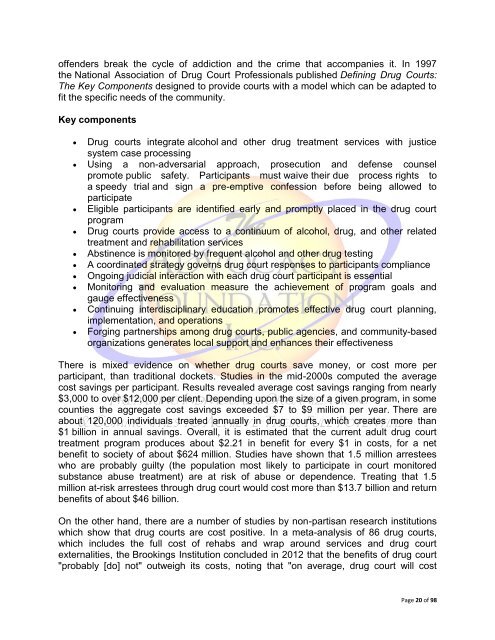The Opioid Crisis in America - Part II (The Drug Culture in the U.S.)
The Opioid Crisis in America - Part II (The Drug Culture in the U.S.)
The Opioid Crisis in America - Part II (The Drug Culture in the U.S.)
You also want an ePaper? Increase the reach of your titles
YUMPU automatically turns print PDFs into web optimized ePapers that Google loves.
offenders break <strong>the</strong> cycle of addiction and <strong>the</strong> crime that accompanies it. In 1997<br />
<strong>the</strong> National Association of <strong>Drug</strong> Court Professionals published Def<strong>in</strong><strong>in</strong>g <strong>Drug</strong> Courts:<br />
<strong>The</strong> Key Components designed to provide courts with a model which can be adapted to<br />
fit <strong>the</strong> specific needs of <strong>the</strong> community.<br />
Key components<br />
<strong>Drug</strong> courts <strong>in</strong>tegrate alcohol and o<strong>the</strong>r drug treatment services with justice<br />
system case process<strong>in</strong>g<br />
Us<strong>in</strong>g a non-adversarial approach, prosecution and defense counsel<br />
promote public safety. <strong>Part</strong>icipants must waive <strong>the</strong>ir due process rights to<br />
a speedy trial and sign a pre-emptive confession before be<strong>in</strong>g allowed to<br />
participate<br />
Eligible participants are identified early and promptly placed <strong>in</strong> <strong>the</strong> drug court<br />
program<br />
<strong>Drug</strong> courts provide access to a cont<strong>in</strong>uum of alcohol, drug, and o<strong>the</strong>r related<br />
treatment and rehabilitation services<br />
Abst<strong>in</strong>ence is monitored by frequent alcohol and o<strong>the</strong>r drug test<strong>in</strong>g<br />
A coord<strong>in</strong>ated strategy governs drug court responses to participants compliance<br />
Ongo<strong>in</strong>g judicial <strong>in</strong>teraction with each drug court participant is essential<br />
Monitor<strong>in</strong>g and evaluation measure <strong>the</strong> achievement of program goals and<br />
gauge effectiveness<br />
Cont<strong>in</strong>u<strong>in</strong>g <strong>in</strong>terdiscipl<strong>in</strong>ary education promotes effective drug court plann<strong>in</strong>g,<br />
implementation, and operations<br />
Forg<strong>in</strong>g partnerships among drug courts, public agencies, and community-based<br />
organizations generates local support and enhances <strong>the</strong>ir effectiveness<br />
<strong>The</strong>re is mixed evidence on whe<strong>the</strong>r drug courts save money, or cost more per<br />
participant, than traditional dockets. Studies <strong>in</strong> <strong>the</strong> mid-2000s computed <strong>the</strong> average<br />
cost sav<strong>in</strong>gs per participant. Results revealed average cost sav<strong>in</strong>gs rang<strong>in</strong>g from nearly<br />
$3,000 to over $12,000 per client. Depend<strong>in</strong>g upon <strong>the</strong> size of a given program, <strong>in</strong> some<br />
counties <strong>the</strong> aggregate cost sav<strong>in</strong>gs exceeded $7 to $9 million per year. <strong>The</strong>re are<br />
about 120,000 <strong>in</strong>dividuals treated annually <strong>in</strong> drug courts, which creates more than<br />
$1 billion <strong>in</strong> annual sav<strong>in</strong>gs. Overall, it is estimated that <strong>the</strong> current adult drug court<br />
treatment program produces about $2.21 <strong>in</strong> benefit for every $1 <strong>in</strong> costs, for a net<br />
benefit to society of about $624 million. Studies have shown that 1.5 million arrestees<br />
who are probably guilty (<strong>the</strong> population most likely to participate <strong>in</strong> court monitored<br />
substance abuse treatment) are at risk of abuse or dependence. Treat<strong>in</strong>g that 1.5<br />
million at-risk arrestees through drug court would cost more than $13.7 billion and return<br />
benefits of about $46 billion.<br />
On <strong>the</strong> o<strong>the</strong>r hand, <strong>the</strong>re are a number of studies by non-partisan research <strong>in</strong>stitutions<br />
which show that drug courts are cost positive. In a meta-analysis of 86 drug courts,<br />
which <strong>in</strong>cludes <strong>the</strong> full cost of rehabs and wrap around services and drug court<br />
externalities, <strong>the</strong> Brook<strong>in</strong>gs Institution concluded <strong>in</strong> 2012 that <strong>the</strong> benefits of drug court<br />
"probably [do] not" outweigh its costs, not<strong>in</strong>g that "on average, drug court will cost<br />
Page 20 of 98

















